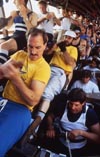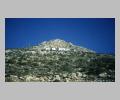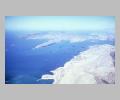|
The Battle of Salamis
Clicking on the thumbnail will open a new browser window.
|
The primary warship of the Athenians was the trireme, an oared sailing ship with three banks of oars on each side. In 1982, the historian and academic, John Morrison, naval architect, John Coates, and writer Frank Welsh formed The Trireme Trust, a joint Greek-British venture to reconstruct an ancient trireme. |
|
Ancient sources indicated that a trireme was powered by 170 rowers, 31 on the top bank and 27 on each of the two lower banks. Rowers discovered that the ideal crew height is 5'10", and those over 6'1" found conditions cramped on board. A series of six sea-trials between 1987 and 1994 demonstrated that the ship could be rowed efficiently and fast, despite almost universal academic opinion that a three-level arrangement of oars was wholly impracticable. |
 |
The primary task of the trireme in battle was to ram an enemy ship with its reinforced metal prow, here decorated with an evil eye to ward off bad luck. After ramming an enemy ship, the crew would board the other ship. At 120 feet long and 15 feet wide, the superior speed and maneuverability of the Athenian trireme gave it an advantage over the bigger, heavier ships in the Persian navy. |
|
Nine days after the Spartans' stand at Thermopylae, the Persian army marched down to Athens and attacked the Acropolis in Athens. The defenders fought by rolling rocks down, but the Persians found a precipitous path and snuck up to the the top. There they slaughtered those who did not commit suicide by leaping from the top of hill. Then they took vengeance for the destruction of Sardis by burning the Parthenon and destroying the other shrines and votive gifts there. The remains of columns from the old Athena Temple, destroyed by the Persians, are built into the north wall of the Acropolis as a reminder of the Persian sack.
|
|
At the same time, the Persian navy sailed from Artemesion around Attica to Athens. The Greek fleet had been warned and withdrew into the narrow strait between Salamis and Piraeus. Here, if you compare this picture of Salamis from the east with Athenaze, page 300, you can see the promontory Cynosura and the little island Psyttaleia. |
|
When the Greek sailors saw the Acropolis in flames, they were ready to desert. But Themistocles persuaded them that they should not pass up this chance to fight the Persians when the location gave them such an advantage. He sent a trusted slave to Xerxes to tell him that the Greeks were squabbling, and if he attacked soon, he would win a great victory. Xerxes believed the ruse and watched the battle from this hill (Mount Aegaleos) on Salamis. |
|
When the Greeks had not begun to leave the harbor, the Persians rowed into the narrow strait between the island and the mainland. The Greeks pulled back to lure them. |
 |
As more and more Persian ships entered, they had no where to maneuver. The Greeks rammed the taller ships and chaos ensued. At the end of the day's fighting, 200 ships in the Persian fleet had sunk or been commandeered and tens of thousands Persian sailors had lost their lives. |
The Trireme Trust, a joint Greek-British venture to reconstruct an ancient trireme, has many more pictures of triremes.
Photo credits: first three photos, courtesy of the Trireme Trust.
North wall of the Acropolis, photograph by Kevin T. Glowacki, Ancient City of Athens.
Aerial view of Salamis from E, photograph by Raymond V. Schoder, S.J., courtesy of Bolchazy-Carducci Publishers.
Height above Salamis from where Xerxes watched, photograph courtesy of Thomas Martin and Ivy Sun.
Aerial view of the bays, from NE, Salamis,
photograph by Raymond V. Schoder, S.J., courtesy of Bolchazy-Carducci Publishers.
Trireme ramming:
3D illustration by The Creative Assembly © 2013.
|







